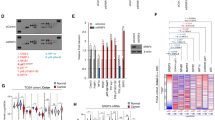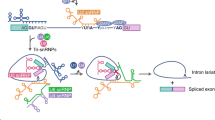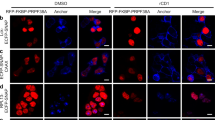Abstract
Serine/arginine-rich (SR) proteins are important regulators of mRNA splicing. Several postsplicing activities have been described for a subset of shuttling SR proteins, including regulation of mRNA export and translation. Using the fibronectin gene to study the links between signal-transduction pathways and SR protein activity, we show that growth factors not only modify the alternative splicing pattern of the fibronectin gene but also alter translation of reporter messenger RNAs in an SR protein–dependent fashion, providing two coregulated levels of isoform-specific amplification. These effects are inhibited by specific small interfering RNAs against SR proteins and are mediated by the AKT kinase, which elicits opposite effects to those evoked by overexpressing SR protein kinases Clk and SRPK. These results show how SR protein activity is modified in response to extracellular stimulation, leading to a concerted regulation of splicing and translation.
This is a preview of subscription content, access via your institution
Access options
Subscribe to this journal
Receive 12 print issues and online access
$189.00 per year
only $15.75 per issue
Buy this article
- Purchase on Springer Link
- Instant access to full article PDF
Prices may be subject to local taxes which are calculated during checkout






Similar content being viewed by others
References
Graveley, B.R. Alternative splicing: increasing diversity in the proteomic world. Trends Genet. 17, 100–107 (2001).
Graveley, B.R. Sorting out the complexity of SR protein functions. RNA 6, 1197–1211 (2000).
Fu, X.D. The superfamily of arginine/serine-rich splicing factors. RNA 1, 663–680 (1995).
Shen, H., Kan, J.L. & Green, M.R. Arginine-serine-rich domains bound at splicing enhancers contact the branchpoint to promote prespliceosome assembly. Mol. Cell 13, 367–376 (2004).
Tacke, R. & Manley, J.L. Determinants of SR protein specificity. Curr. Opin. Cell Biol. 11, 358–362 (1999).
Bourgeois, C.F., Popielarz, M., Hildwein, G. & Stevenin, J. Identification of a bidirectional splicing enhancer: differential involvement of SR proteins in 5′ or 3′ splice site activation. Mol. Cell. Biol. 19, 7347–7356 (1999).
Hastings, M.L. & Krainer, A.R. Pre-mRNA splicing in the new millennium. Curr. Opin. Cell Biol. 13, 302–309 (2001).
Spector, D.L., Fu, X.D. & Maniatis, T. Associations between distinct pre-mRNA splicing components and the cell nucleus. EMBO J. 10, 3467–3481 (1991).
Caceres, J.F., Misteli, T., Screaton, G.R., Spector, D.L. & Krainer, A.R. Role of the modular domains of SR proteins in subnuclear localization and alternative splicing specificity. J. Cell Biol. 138, 225–238 (1997).
Lai, M.C., Lin, R.I. & Tarn, W.Y. Transportin-SR2 mediates nuclear import of phosphorylated SR proteins. Proc. Natl. Acad. Sci. USA 98, 10154–10159 (2001).
Caceres, J.F., Screaton, G.R. & Krainer, A.R. A specific subset of SR proteins shuttles continuously between the nucleus and the cytoplasm. Genes Dev. 12, 55–66 (1998).
Huang, Y. & Steitz, J.A. SRprises along a messenger's journey. Mol. Cell 17, 613–615 (2005).
Lemaire, R. et al. Stability of a PKCI-1-related mRNA is controlled by the splicing factor ASF/SF2: a novel function for SR proteins. Genes Dev. 16, 594–607 (2002).
Zhang, Z. & Krainer, A.R. Involvement of SR proteins in mRNA surveillance. Mol. Cell 16, 597–607 (2004).
Sanford, J.R., Gray, N.K., Beckmann, K. & Caceres, J.F. A novel role for shuttling SR proteins in mRNA translation. Genes Dev. 18, 755–768 (2004).
Shin, C. & Manley, J.L. Cell signalling and the control of pre-mRNA splicing. Nat. Rev. Mol. Cell Biol. 5, 727–738 (2004).
Patel, N.A. et al. Insulin regulates alternative splicing of protein kinase C beta II through a phosphatidylinositol 3-kinase-dependent pathway involving the nuclear serine/arginine-rich splicing factor, SRp40, in skeletal muscle cells. J. Biol. Chem. 276, 22648–22654 (2001).
van der Houven van Oordt, W. et al. The MKK(3/6)-p38-signaling cascade alters the subcellular distribution of hnRNP A1 and modulates alternative splicing regulation. J. Cell Biol. 149, 307–16 (2000).
Xie, J., Lee, J.A., Kress, T.L., Mowry, K.L. & Black, D.L. Protein kinase A phosphorylation modulates transport of the polypyrimidine tract-binding protein. Proc. Natl. Acad. Sci. USA 100, 8776–8781 (2003).
Gui, J.F., Lane, W.S. & Fu, X.D. A serine kinase regulates intracellular localization of splicing factors in the cell cycle. Nature 369, 678–682 (1994).
Colwill, K. et al. The Clk/Sty protein kinase phosphorylates SR splicing factors and regulates their intranuclear distribution. EMBO J. 15, 265–275 (1996).
Rossi, F. et al. Specific phosphorylation of SR proteins by mammalian DNA topoisomerase I. Nature 381, 80–82 (1996).
Kornblihtt, A.R. et al. The fibronectin gene as a model for splicing and transcription studies. FASEB J. 10, 248–257 (1996).
Manabe, R., Oh-e, N. & Sekiguchi, K. Alternatively spliced EDA segment regulates fibronectin-dependent cell cycle progression and mitogenic signal transduction. J. Biol. Chem. 274, 5919–5924 (1999).
Muro, A.F. et al. Regulated splicing of the fibronectin EDA exon is essential for proper skin wound healing and normal lifespan. J. Cell Biol. 162, 149–160 (2003).
Caputi, M. et al. A novel bipartite splicing enhancer modulates the differential processing of the human fibronectin EDA exon. Nucleic Acids Res. 22, 1018–1022 (1994).
Lavigueur, A., La Branche, H., Kornblihtt, A.R. & Chabot, B. A splicing enhancer in the human fibronectin alternate ED1 exon interacts with SR proteins and stimulates U2 snRNP binding. Genes Dev. 7, 2405–2417 (1993).
Blaustein, M. et al. Mammary epithelial-mesenchymal interaction regulates fibronectin alternative splicing via phosphatidylinositol 3-kinase. J. Biol. Chem. 279, 21029–21037 (2004).
Bos, J.L. ras oncogenes in human cancer: a review. Cancer Res. 49, 4682–4689 (1989).
Oliva, J.L. et al. The P34G mutation reduces the transforming activity of K-Ras and N-Ras in NIH 3T3 cells but not of H-Ras. J. Biol. Chem. 279, 33480–33491 (2004).
Zhao, J.J. et al. Human mammary epithelial cell transformation through the activation of phosphatidylinositol 3-kinase. Cancer Cell 3, 483–495 (2003).
Buratti, E. et al. RNA folding affects the recruitment of SR proteins by mouse and human polypurinic enhancer elements in the fibronectin EDA exon. Mol. Cell. Biol. 24, 1387–1400 (2004).
Cramer, P. et al. Coupling of transcription with alternative splicing: RNA pol II promoters modulate SF2/ASF and 9G8 effects on an exonic splicing enhancer. Mol. Cell 4, 251–258 (1999).
Kuroyanagi, N., Onogi, H., Wakabayashi, T. & Hagiwara, M. Novel SR-protein-specific kinase, SRPK2, disassembles nuclear speckles. Biochem. Biophys. Res. Commun. 242, 357–364 (1998).
Gingras, A.C., Kennedy, S.G., O'Leary, M.A., Sonenberg, N. & Hay, N. 4E–BP1, a repressor of mRNA translation, is phosphorylated and inactivated by the Akt(PKB) signaling pathway. Genes Dev. 12, 502–513 (1998).
Li, X., Shambaugh, M.E., Rottman, F.M. & Bokar, J.A. SR proteins Asf/SF2 and 9G8 interact to activate enhancer-dependent intron D splicing of bovine growth hormone pre-mRNA in vitro. RNA 6, 1847–1858 (2000).
Pelisch, F., Blaustein, M., Kornblihtt, A.R. & Srebrow, A. Cross-talk between signaling pathways regulates alternative splicing: a novel role for JNK. J. Biol. Chem. 280, 25461–25469 (2005).
Matter, N., Herrlich, P. & Konig, H. Signal-dependent regulation of splicing via phosphorylation of Sam68. Nature 420, 691–695 (2002).
Patel, N.A. et al. Molecular and genetic studies imply Akt-mediated signaling promotes protein kinase CβII alternative splicing via phosphorylation of serine/arginine-rich splicing factor SRp40. J. Biol. Chem. 280, 14302–14309 (2005).
Du, K., Peng, Y., Greenbaum, L.E., Haber, B.A. & Taub, R. HRS/SRp40-mediated inclusion of the fibronectin EIIIB exon, a possible cause of increased EIIIB expression in proliferating liver. Mol. Cell. Biol. 17, 4096–4104 (1997).
Gilbert, W. & Guthrie, C. The Glc7p nuclear phosphatase promotes mRNA export by facilitating association of Mex67p with mRNA. Mol. Cell 13, 201–212 (2004).
Sanford, J.R., Ellis, J., Cazalla, D. & Caceres, J.F. Reversible phosphorylation differentially affects nuclear and cytoplasmic functions of splicing factor 2/alternative splicing factor. Proc. Natl. Acad. Sci. USA 102, 15042–15047 (2005).
Prasad, J., Colwill, K., Pawson, T. & Manley, J.L. The protein kinase Clk/Sty directly modulates SR protein activity: both hyper- and hypophosphorylation inhibit splicing. Mol. Cell. Biol. 19, 6991–7000 (1999).
Cavaloc, Y., Bourgeois, C.F., Kister, L. & Stevenin, J. The splicing factors 9G8 and SRp20 transactivate splicing through different and specific enhancers. RNA 5, 468–483 (1999).
Hochbaum, D., Tanos, T., Ribeiro-Neto, F., Altschuler, D. & Coso, O.A. Activation of JNK by Epac is independent of its activity as a Rap guanine nucleotide exchanger. J. Biol. Chem. 278, 33738–33746 (2003).
Ahmed, N.N., Grimes, H.L., Bellacosa, A., Chan, T.O. & Tsichlis, P.N. Transduction of interleukin-2 antiapoptotic and proliferative signals via Akt protein kinase. Proc. Natl. Acad. Sci. USA 94, 3627–3632 (1997).
Denegri, M. et al. Stress-induced nuclear bodies are sites of accumulation of pre-mRNA processing factors. Mol. Biol. Cell 12, 3502–3514 (2001).
Duncan, P.I., Stojdl, D.F., Marius, R.M., Scheit, K.H. & Bell, J.C. The Clk2 and Clk3 dual-specificity protein kinases regulate the intranuclear distribution of SR proteins and influence pre-mRNA splicing. Exp. Cell Res. 241, 300–308 (1998).
de la Mata, M. et al. A slow RNA polymerase II affects alternative splicing in vivo. Mol. Cell 12, 525–532 (2003).
Acknowledgements
We thank M. de la Mata, J.P. Fededa, I. Schor, E. Petrillo and M. Alló for encouraging discussions as well as V. Buggiano and R. Fernandez for technical help. This work was supported by grants from Fundación Antorchas, Universidad de Buenos Aires, Agencia Nacional de Promoción Científica y Tecnológica and Consejo de Investigaciones Científicas y Técnicas (CONICET). M.B., F.P., T.T., M.J.M. and D.W. are recipients of doctoral fellowships from the CONICET. A.S., J.P.M, A.R.K. and O.A.C. are investigators of the CONICET. A.R.K. is an International Research Scholar of the Howard Hughes Medical Institute. We also acknowledge support from the Medical Research Council (J.F.C.) and the Caledonian Research Foundation (J.R.S.).
Author information
Authors and Affiliations
Corresponding author
Ethics declarations
Competing interests
The authors declare no competing financial interests.
Supplementary information
Supplementary Fig. 1
SiRNA against SF2/ASF and 9G8 completely blocks overexpression of T7-SF2/ASF and T7-9G8, respectively. (PDF 316 kb)
Rights and permissions
About this article
Cite this article
Blaustein, M., Pelisch, F., Tanos, T. et al. Concerted regulation of nuclear and cytoplasmic activities of SR proteins by AKT. Nat Struct Mol Biol 12, 1037–1044 (2005). https://doi.org/10.1038/nsmb1020
Received:
Accepted:
Published:
Issue Date:
DOI: https://doi.org/10.1038/nsmb1020
This article is cited by
-
Oncogenic KRAS alters splicing factor phosphorylation and alternative splicing in lung cancer
BMC Cancer (2022)
-
Live and let die: signaling AKTivation and UPRegulation dynamics in SARS-CoVs infection and cancer
Cell Death & Disease (2022)
-
Emerging roles of spliceosome in cancer and immunity
Protein & Cell (2022)
-
Identification of splice regulators of fibronectin-EIIIA and EIIIB by direct measurement of exon usage in a flow-cytometry based CRISPR screen
Scientific Reports (2021)
-
SRSF1 inhibits autophagy through regulating Bcl-x splicing and interacting with PIK3C3 in lung cancer
Signal Transduction and Targeted Therapy (2021)



